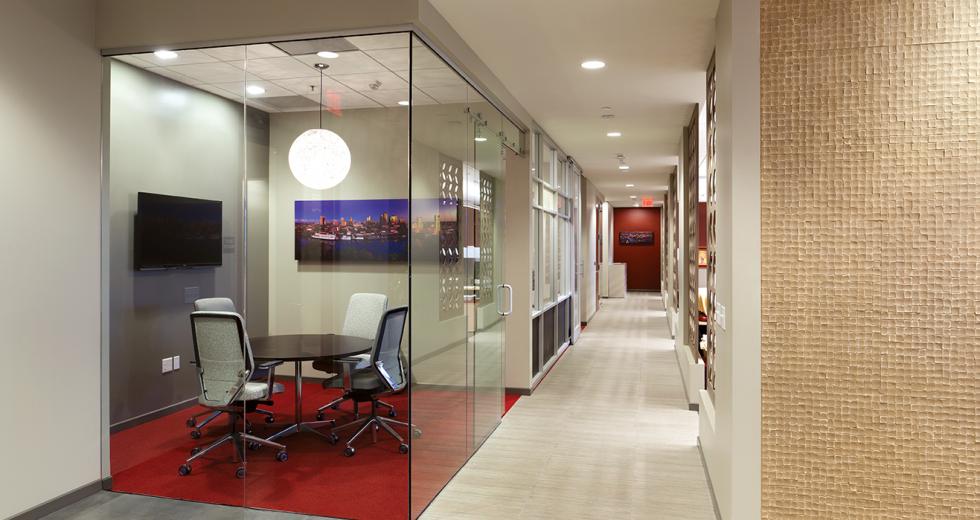Walk into any coffee shop and it’s obvious that the place we call “the office” has changed. Many of the people sitting at tables are likely mixing laptops with lattes as they browse email and write reports. Some may be pitching a sale over coffee.
In the changing world of work, the corner office with a desk the size of an aircraft carrier is no longer the hallmark of success it once was. Instead, more companies are looking to reduce their amount of wasted space, squeezing more people into fewer square feet.
It’s a shift in office design that is strongest in large markets where real estate costs can easily double those in Sacramento, and it’s more prevalent in Fortune 500 companies and certain industries. But it is a trend that is beginning to catch on in some segments of the Capital Region’s commercial real estate market.
The downsizing of individual work spaces isn’t expected to hamper the commercial leasing market in Sacramento. A recent up-tick in the economy saw an additional 1.8 million square feet of office space filled in 2013. Most experts are optimistic that growth will continue in 2014 as the economy continues to stabilize.
But employees can expect less hip room in many offices as companies look to design smarter — though not necessarily smaller — footprints and leave room for future growth.
“My consultations often start by talking to someone who has walked through their office and wondered where everybody is,” says Antonia Cardone, senior vice president of corporate strategy at the global real estate firm DTZ. According to Cardone, hundreds of time-and-motion studies have concluded that the average worker is away from his or her desk up to 65 percent of the day. Since real estate is one of the top two line items in any budget, “anyone writing a big check for rent, electricity and heat or cleaning services may begin to ask why,” she says.
What was once an almost-universal office standard of roughly 250 square feet per person has shrunk by about half in recent years. Despite what those numbers suggest, the end result is far from the Dilbert-esque drudgery of cubicle hell. Space planners are taking advantage of a mobile workforce, globalization and technology to design offices that better reflect the way people actually work.
“Even modern law offices are different from 20 years ago,” says Steve Guest, principal of RMW Architecture & Interiors. Traditionally large users of floor space, many firms are taking advantage of digital law libraries and leaving shelves of books behind.
Many of Guest’s clients initially approach an office remodel hoping to save real estate costs, he says. “But the discussion quickly morphs into how their efficiency will go up to reflect how their business strategies have evolved.”
Few American workers sit alone in an office doing one task all day. More often, they work in different environments and with different colleagues as they juggle phone calls, emails, meetings, technology and collaboration.
Designers approach an office re-do by defining the company’s motivations, whether to increase sales, improve research and development or simply make the space more enjoyable for employees. “Once we understand those goals and can translate them into a business layout, we can design a collection of spaces that encourage that behavior,” Cardone says.
Technology plays a large role in how offices look today. “Wireless is everywhere and laptops all have cameras and there are a million ways to text,” notes Cardone. “We have lots of tools that let us move around and talk to one another easily, so we don’t have to sit in a box with heat pumped into it all day long.”
Intel-GE Care Innovations in Roseville designs medical devices and shows how technology can elevate even the simplest connection between employees. Cameras mounted in the hallways allow workers here to see their colleagues who may be walking down the hallway in New York. The result is a high tech, long-distance version of bumping into someone, which may spark an impromptu brainstorming session or a reminder to call that person later.
After 25 years in one location, the Sacramento office of Cushman & Wakefield real estate had outgrown its floor plan. More importantly, it had outgrown its old way of doing business. Typical of most real estate firms, 65 percent of its 5,000-square-foot space was consumed by private offices. “We collectively agreed to give up that environment,” says Managing Director Ron Thomas. “When we accepted that we had to relocate, we had to ask ourselves how we would start over.”

He had been advising clients to downsize as they worked to recover from the recession. “Everyone has had to do more with less, and we decided that if we were going to talk the talk, we had to walk the walk,” he says.
The private offices are gone from the new address Cushman & Wakefield moved into a year ago. Brokers work in an open space at bench-style desks that offer computer plug-ins and height adjustment. Reversing a traditional pattern, 60 percent of the new floor plan is dedicated to communal areas that promote more interaction among employees. Glass or screen walls are used to separate distinct working areas. Acoustically enclosed conference rooms are available for confidential conversations with clients.
The 5,000-square-foot suite is the same size as the one Cushman & Wakefield vacated. But with the more efficient layout, the average space for each of the 19 employees has been reduced from between 250 to 300 square feet per person to about 185, giving the company room to add another half dozen employees in the future. Economically, the downsizing made sense, says Thomas, but there have also been intangible benefits produced by changing the office culture.
Tearing down physical walls also tore down less visible walls that inhibited communication and teamwork. With more conversation and places for employees to congregate, junior staffers now have more frequent opportunities to share ideas and learn from veterans. “It sparked more creativity and teamwork, and we’re seeing a lot more organic conversations that lead to a transaction,” Thomas says.
One of Sacramento’s largest office remodels is for global real estate firm CBRE, which this month will move 96 employees into an 18,000-square-foot space on Capitol Mall. The overall footprint is no smaller than the company’s previous location, but the design includes 10 different work environments, from temporary day-use offices to lounges and quiet rooms. Cost cutting is not driving the new interior design, according to Georgia Collins, managing director of Workplace Strategy. By taking advantage of mobility and technology, “We’re investing in the right places to make our employees more efficient,” she says.
Despite decreasing the square footage per workspace, these open-concept designs are decidedly not downscale. Glass walls provide transparency and access to natural light. Communal areas are likely to be informal and casual. Designers say those factors make workers more productive and efficient. They also give companies a competitive edge in recruiting top talent. “If you put people in smaller spaces, they have to be nicer,” contends Guest. “You put people in an environment like a Starbucks or a living room because it stimulates the brain.”
Offices, he says, no longer hog the prime real estate along the windows. Instead, they are positioned to allow natural light to be brought into the interior spaces, which studies show enables people to think more creatively and work more energetically than in artificial light.
With a smaller footprint, companies may spend less money on leases but more on furniture and upgraded building materials. Ultimately, Guest contends, companies that want to retain top performers or recruit talent need to invest in making their workplaces attractive.
Cardone, who talks to as many as 100 companies a year about the connection between workplace design and business strategy, says, “In today’s business world, the people they are trying to recruit want to work with people who are visible and approachable. Companies that stay with a traditional office environment may find it difficult to recruit the talent they might seek.”
Most analysts agree it’s unlikely another Fortune 500 company will establish its headquarters in Sacramento, considering the city’s proximity to the Bay Area. But, with lower housing and operating costs, the market is attractive for satellite or back-office operations. Call centers, insurance or accounting companies are prime candidates for smart downsizing, especially in footprints of 50,000 square feet or less.
“I prefer to call it right-sizing,” says DTZ Senior Vice President Mark Hefner, who notes that a lack of jobs is a much bigger brake on commercial leasing activity than the so-called downsizing trend. If those jobs materialize, commercial leasing activity is expected to keep stride, building on the occupancy gains made in 2013.
But as companies expand and increase density in the office, they could be squeezed by another space problem: parking. “If this downsizing trend is here to stay, that could be the next big issue,” says Williams.
Recommended For You

Arts & Aesthetics
Fine art collections serve as on-site museums for some of Sacramento’s culture-loving companies.

Home Office Tricks and Tips
How to design a comfortable and productive workspace
Technological innovations, workforce trends and entrepreneurial spirits are allowing more American workers to step away from cubicles and corner offices and into the comforts of their own homes.




Comments
Interesting